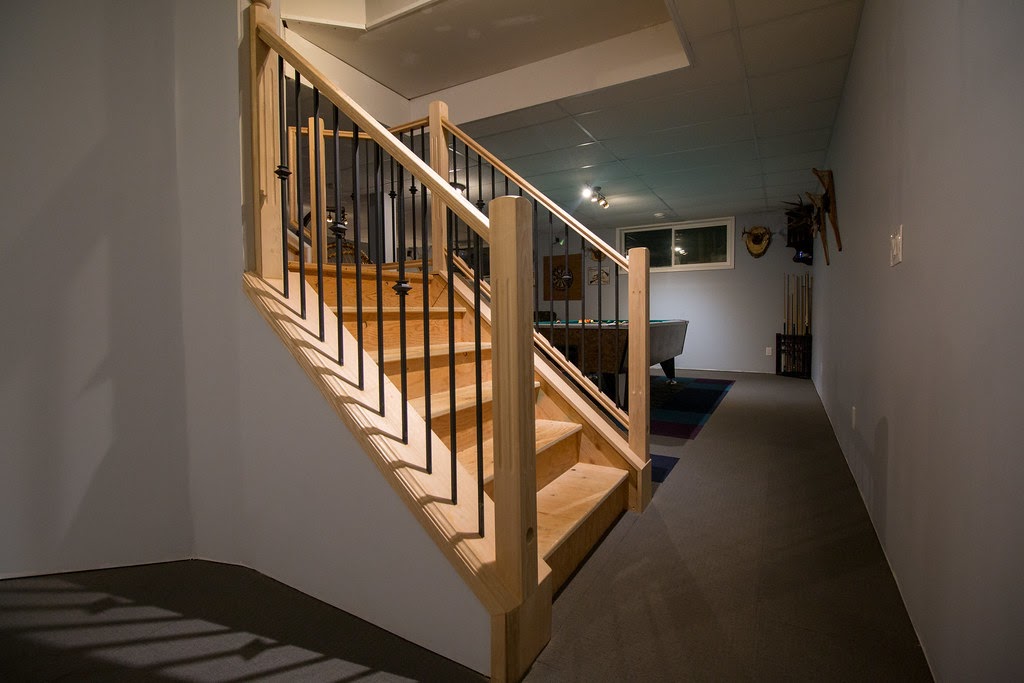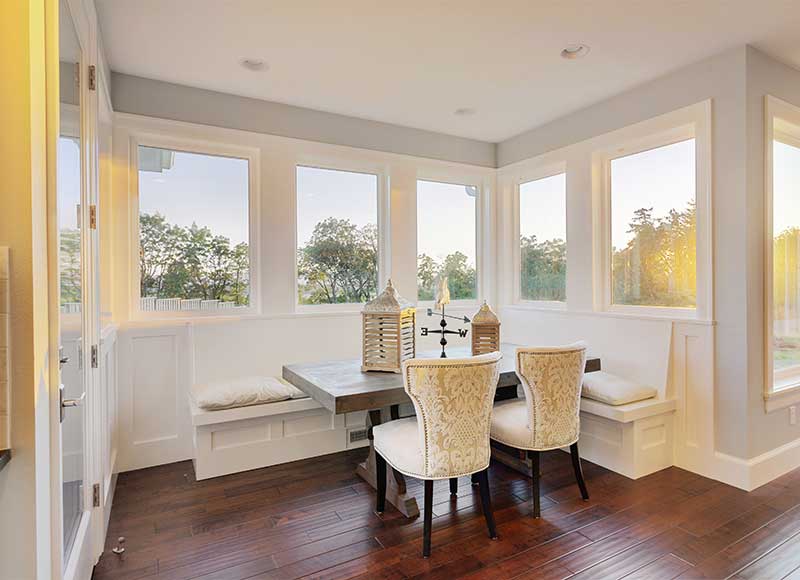Over the years, basement renovations have become increasingly popular, and for good reason. Basement renovations are an easy way to add more square footage to your home while also being a blank canvas for you to do anything you want. The problem is that basements are cold, and it makes them uncomfortable. One of the first things you should do when renovating a basement is find the best basement heating options. Here is what you should know about basement heating ideas and options to consider.
Why Heating A Basement is Difficult
Basements are notoriously cold places. While there are many reasons, the primary reason is their location: basements are the lowest point of your home, underground, where it is exposed to cooler temperatures. Other factors that can add to the difficulty of adequately heating basements include moisture problems, insufficient sealing and insulation, and poor ventilation. Fixing these problems could help significantly, but you also need to consider a basement heating solution.
Proper Ways to Use Heating for a Basement
While there are benefits to keeping your basement heated throughout winter, you need to use your heat properly and effectively.
Use a Smart or Programmable Thermostat
A smart or programmable thermostat is essential to a basement heating system. These thermostats have numerous features that allow for more precise temperature control and scheduling. Ideally, you want a thermostat that will allow for zoning which lets you control the temperatures within the basement without affecting the entire house.
Only Heat the Space You’re Using
Use a smart thermostat to ensure you’re mainly directing the heat to the space you’re using, so you aren’t needlessly heating unused space and wasting energy.
Install An Energy Efficient Heating System
The best way to properly heat your basement is to find basement heater options that are energy-efficient and effective, especially if you are trying to heat a finished basement.
Types of Basement Heating Solutions
There is no shortage of heating options you can use in a basement. Here are some of the best ways to heat a basement:
1. Add Registers to the HVAC System
If you have an existing HVAC system, consider adding registers for the basement. This will allow you to control the basement’s temperature to create a more comfortable and usable space. You may need to add additional ductwork and a system upgrade to accommodate the extra registers properly.
2. Install a Fireplace
Traditional fireplaces are an aesthetically pleasing way to add heating to a basement. You can choose wood, gas, or electric, depending on your preference. Each has advantages and disadvantages, but fireplaces, especially gas and wood, should never be left unattended.
3. Wood Pellet Stoves
Stoves are a rustic heating option, and wood pellets are a great basement heating option. A wood pellet stove burns EPA-certified pellets and circulates the hot air produced with a small fan that doesn’t require any electrical connections. While you only have to refuel the stove once a day, you must also have an external vent to remove the carbon monoxide produced during burning.
4. Wall Heaters
Wall heaters can be gas or electric and only heat the space while they are on. They have the advantage of being compact and not taking up floor space, but you need to have proper ventilation for gas wall heaters or an electrical outlet for electric versions.
5. Portable Heat Pumps
Portable heat pumps, while noisy, are versatile options that you can easily move around as needed. They provide cool air during the summer and heat in the winter. These are energy-efficient options; more high-tech models can connect with an AC controller to give them smart functions.
6. Heated Baseboards
Heated baseboards are another option to heat a basement. These slim options are installed on the wall and need no additional vents or ductwork. There are convection and hydronic heated baseboards; both heat the air closer to the floor, which rises to heat the surrounding area.
7. Electric Space Heaters
Another temporary, inexpensive option for basement heating is electric space heaters. They start heating once you plug them in and turn them on. While efficient, they are best for spot-heating for short periods, but they are not energy efficient and can pose a fire risk.
8. Radiant Floor Heating
Radiant floor heating is one of the best ways to heat a basement, especially if you’re remodeling or creating a finished basement. This type of heating uses infrared radiation to deliver heat through resistive materials like wires or water pipes. They are highly efficient systems that evenly distribute heat in order to prevent hot and cold spots. Radiant floor heating systems are quiet and don’t circulate dust and allergens since they do not blow air like other systems. There are two forms of radiant floor heating.
Best Way to Heat an Unfinished Basement vs. the Best Way to Heat a Finished Basement
While many basement heating solutions are available, it is important to consider the condition of your basement. You may want to consider different heating solutions for unfinished and finished basements.
Before considering any basement heating ideas for an unfinished basement, you need to insulate the walls and ceiling. This will help seal the room and prevent heat loss. You can also consider insulating the floors for added protection from the cold. The best way to heat a basement that is unfinished is with space heaters, which you can unplug when you aren’t using them. A wood pellet stove or fireplace can also be a good solution, especially if you use the space as a workshop. Alternatively, you can add ductwork to your existing system to get heat.
Suppose you intend to convert the space into a finished basement. In that case, it is worth considering heating your basement with something like radiant flooring to make it more comfortable and enjoyable. For added security from the cold, you can pair a radiant floor basement heating solution with additional ductwork added to the existing HVAC system.
4 Reasons Radiant Floor Heating is the Best Way to Heat a Basement
Heating is the primary concern for basements, so it is important to consider the right solution for heating your basement. While there are many options, radiant heat flooring is the best way to heat a basement. Radiant flooring, especially electric radiant flooring, is a clean, quiet option that is easy to install. Other benefits worth considering include:
1. Low Long-Term Costs
One thing that makes electric radiant flooring the best heating for basement spaces is the low long-term costs. These systems allow you to create heating zones, which you can control via the thermostat. This ensures you aren’t wasting electricity by heating empty rooms, which helps to lower your energy bill.
2. Minimal Equipment
The problem with most heating systems is that they take up space in some way. HVAC systems and boilers require the most space, but even options like wall heaters take away valuable wall space. With radiant flooring, everything under the floor is completely out of sight.
3. No Maintenance
Once electrical radiant heating is in place, that’s it. You don’t have to worry about performing maintenance or parts breaking down and requiring replacement. It is a maintenance-free system that will work for years.
4. Reliable, Consistent Heating for Basements
Radiant heat flooring is one of the best ways to heat a basement; once installed, all you need is the right compatible thermostat. A programmable or smart thermostat will make everything virtually automatic once you’ve set your schedules and zones, that will turn on and off based on your settings.
Two Types of Radiant Heating for Basements
As mentioned before, there are two types of radiant floor heating systems: electric and hydronic. While the basic functions of these systems are the same, there are notable differences, and each has advantages and disadvantages.
Hydronic Systems
Hydronic radiant heat uses hot water as the heat conductor. The water is generated by a boiler system, which circulates it through the piping installed under your floors. It is one of the most effective basement heater options and it has low operating costs.
Disadvantages of hydronic systems include that they are expensive to install, require maintenance, and aren’t compatible with many flooring materials. The boiler also requires space, which takes away from the usable area in the room.
Electric Systems
Electric radiant systems are the best electric heaters for basement spaces. This form of radiant heating relies on electric mats and cables installed under the floor. They don’t require bulky equipment or maintenance and are compatible with various floor coverings.
How Safe is Radiant Flooring?
Hydronic and electric radiant heating are some of the safest heating solutions for basement areas. Unlike fireplaces, stoves, furnaces, and space heaters, radiant flooring has no fire risk. It won’t circulate allergens or germs like systems that require air circulation, to ensure that the air is cleaner and safer.
Make The Basement Heating More Efficient
Even with the best heating for basement areas, you still need to take steps to help keep the warmth inside. Here are some tips on how to heat a basement efficiently beyond having the right system in place:
Keep Doors and Windows Closed
If you have a large basement with separate rooms, don’t open windows or doors in unused rooms. Otherwise, heat will go into these spaces, which is a waste of energy and money.
Make Sure The Basement is Properly Insulated
One of the best ways to heat a basement efficiently is to ensure adequate insulation in your walls, ceiling, and floor. Insulation will prevent heat loss and allow your systems to work at lower temperatures to save money.
For the best results, you need to insulate your walls using a rigid foam board with an R-value of R-13 to R-15 between the studs. The ceiling should have insulation with a minimum of R-30 to prevent heat from entering the floor above.
Seal Windows and Exterior Doors
Some basements have windows and exterior doors. If your basement has original windows and doors, there is a chance their seals are old and failing, which allows heat to escape and cold air to enter. Fix this by sealing the exterior side with a high-quality exterior sealant. You can also add caulking around the inside for added security.
If gaps exist between the windows and door frames, fill them with non-expanding foam insulation or another type of insulation before patching the hole. You may also want to consider replacing old windows with energy-efficient options.
Ensure Ducts and Vents Are Properly Sealed
If you have an HVAC system, checking that your air ducts are sealed properly is vital. If they aren’t, hot air can escape through the cracks, which results in energy loss.
An HVAC company can use special cameras to check for and seal gaps effectively.
Choose the Right Flooring for Radiant Heating
While electric radiant heat flooring is compatible with more flooring materials, some materials transfer old heat better than others. Tile and stone, for example, have very high thermal conductivity; they hold and transfer the heat better and can also be heated to higher temperatures. Hardwood is another option with high thermal conductivity.
Radiant Flooring, the Best Way to Heat a Basement
Turning a basement into extra living space is a big project. You want it to be attractive and comfortable, and one of the ways to do that is by installing a reliable basement heating system. While there are many options, the most reliable option is electric radiant heat flooring. Warmup specializes in radiant heating, and we offer a selection of systems compatible with most flooring materials. Combined with our subfloor insulation boards, you will have the most efficient basement heating that can be found..
If you’re interested in learning more, contact us at Warmup today. We can show you our different systems and give you a quote for your basement project with everything you need!





![Thumbnail [200x250]](/wp-content/uploads/Indoor-Systems-Page-Image.png)
![Thumbnail [200x250]](/wp-content/uploads/image-13.png)
![Thumbnail [200x250]](/wp-content/uploads/Projects-Image.png)